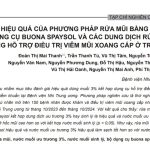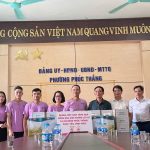
Hỏi Đáp cùng chuyên gia tư vấn BUONA
Hướng dẫn sử dụng chuyên mục hỏi đáp
Thông tin trong chuyên mục chỉ mang tính chất tham khảo, việc điều trị cần liên hệ với bác sỹ để có thông tin chính xác.
- Trước khi đặt câu hỏi mới, hãy sử dụng chức năng " Tìm câu hỏi" để tìm câu hỏi tương tự
- Sử dụng chức năng " Kiểu sắp xếp" để sắp xếp hiển thị câu hỏi theo thứ tự mong muốn
- Bấm vào nút " Đặt câu hỏi" để gửi câu hỏi.
- Việc bình luận, bình chọn sẽ giúp bạn tích điểm và được ưu tiên trả lời khi đặt câu hỏi
- Những câu hỏi, comment không phù hợp sẽ không được đăng hoặc bị xóa bởi ban Quản trị, nick comment có thể bị khiển trách hoặc xóa nick tùy theo mức độ nghiêm trọng của vi phạm.
Xin chào Buona,
Con trai tôi 2 tuổi, bé bị viêm mũi dị ứng từ bé. Hiện tại bé đã 2 tuổi nhưng thường xuyên bị viêm mũi dị ứng vào thời điểm giao mùa, hoặc mùa thu – đông. Bệnh ảnh hưởng nhiều đến khả năng hô hấp và phát triển của cháu. Vì vậy, tôi muốn sử dụng sản hẩm Nebial KIT để vệ sinh mũi cho bé hàng ngày, xin vui lòng tư vấn cách thức sử dụng?
3918 answers
The ghost town that has stood empty for more than a century
[url=https://www.easilytrading.ru/utl-club-obzor/]гей порно[/url]
There’s a large and very dignified school in Kayakoy. There are narrow streets, lined with houses, that wend and rise up both sides of a steep valley. There’s an ancient fountain in the middle of the town. And there are churches, one with million-dollar hilltop views over the blue Aegean.
But, for most of the past 100 years, there have been no people.
Kayakoy, in southwestern Turkey’s Mugla Province, is a true ghost town. Abandoned by its occupants and haunted by the past. It’s a monument, frozen in time – a physical reminder of darker times in Turkey.
With hillsides dotted by countless crumbling buildings slowly being swallowed by greenery, and endless views into vanished lives, it’s also a fascinating and starkly beautiful place to visit. In summer, under clear skies and blazing suns, it’s eerie enough. Even more so in cooler seasons, wreathed in mountain or sea mists.
Just over a century ago, Kayakoy, or Levissi as it was known, was a bustling town of at least 10,000 Greek Orthodox Christians, many of whom were craftspeople who lived peacefully alongside the region’s Muslim Turkish farmers. But in the upheaval surrounding Turkey’s emergence as an independent republic, their simple lives were torn apart.
Tensions with neighboring Greece after the Greco-Turk war ended in 1922 led to both countries ejecting people with ties to the other. For Kayakoy, that meant a forced population exchange with Muslim Turks living in Kavala, in what is now the Greek region of Macedonia and Thrace.
But the newly arrived Muslims were reputedly less than happy with their new home, swiftly moving on and leaving Kayakoy to fall to ruin.
Trạng thái câu hỏi







